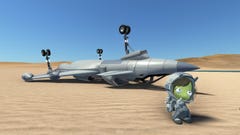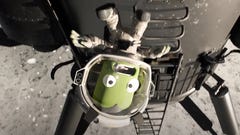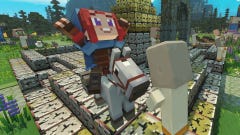Kerbal Space Program 2 early access review: a catastrophic re-entry
Failure to launch
Oh no, poor Kerbal Space Program 2. The extremely anticipated sequel to everyone’s favourite rocket-building space exploration game is a hot mess. A list of bugs longer than a Saturn V reads like a terrible medical diagnosis: quivering periapsis, unpredictable methane leakage, late-stage separation anxiety, loose payloads, non-stop burning, and sensitive nodes.
The developers, smiling bravely in circumstances presumably beyond their control, describe the launch as like dropping a kid off for their first day at school. Well the kid forgot their lunchbox, their uniform, their books and their pencil case. They showed up at the wrong school, on a Saturday during half-term. If you were stranded on a desert island and had to recreate Kerbal Space Program from memory using nothing but coconuts and string, it would look something like Kerbal Space Program 2. The game is nowhere approaching finished, it barely resembles the promotional videos, and it isn’t ready, even by Early Access standards.
If the original game passed you by, here’s how it works. You run a space centre in a fully simulated and persistent solar system, designed to be roughly similar to our own, with analogues of Jupiter and Mars and Venus all booking it around a central star. Using a toy chest of Lego-style, snap-together parts, you build rocket ships capable of safely (or unsafely) ferrying your crew of little green kerbonauts into orbit, and eventually to the surfaces of other planets and moons (and back home again, if you’re feeling ambitious).
The cartoonish graphics are underpinned by a punishingly realistic physics system, which draws on real-world orbital mechanics to drive the simulation. Your earliest experimental rockets collapse under their own weight, or rapidly disassemble themselves mid-launch. Proper staging is needed to neatly decouple spent fuel tanks as you blast through the soupiest parts of the lower atmosphere, shedding more and more of your rocket like a big self-peeling Cheestring, until you’re going sideways faster than gravity can catch you.
.jpg?width=690&quality=80&format=jpg&auto=webp)
.jpg?width=690&quality=80&format=jpg&auto=webp)
.jpg?width=690&quality=80&format=jpg&auto=webp)
You’ll eventually start dropping terms like delta-V, Hohmann transfers and the Oberth effect into polite dinner conversation. The first time you touch down on the Mun without any fatalities is one of the greatest feelings in games – you’ll stare fawningly at your tin can lander, sitting there peacefully on the regolith, as if it were your own newborn, metal child.
Over the years, KSP1 became more complex. It evolved from a simple sandbox into a full campaign, with science gathering, contracts, resources and tech trees. You can populate your solar system with a network of solar-powered comms satellites, linking together remote orbital space stations and beaming a constant feed of fresh data back to your space centre. Mod-support transformed the game's visuals and added a library of player-made parts to choose from. It is a giant, weird, and not-always-welcoming game.
"There are no missions to undertake, so you’re limited to the “make your own fun” of the sandbox."
But while the original game still exists, a full-price Early Access version of KSP2 was always going to be a tough sell, no matter the condition it arrived in. Setting aside that all-new features like multiplayer and interstellar travel aren’t implemented yet, the sequel is missing many of the basic features found in the original game. There are no missions to undertake, so you’re limited to the “make your own fun” of the sandbox. There are fewer parts to build with. Aspects of the physics simulation just aren’t here either. There are heat shields, for example, but they’re pointless as ships don’t actually heat up on re-entry.
.jpg?width=690&quality=80&format=jpg&auto=webp)
There are improvements too. Every craft now has a parts manager window, which lets you pick out and control bits of your ship using a drop down menu, rather than having to hunt around for it in the dark with your mouse cursor. There’s a well-developed tutorial system designed to help new players get to grips with how rockets and orbits work. Wings are now made by customising their shape with a series of sliders, rather than haphazardly bolting them together like jigsaw pieces. The game sounds incredible too, featuring a fully orchestrated score and using audio recorded from actual rocket engines.
The vertical assembly building and spaceplane hangar have been merged into one big workshop, which comes with a few quality of life improvements. Unattached parts don’t get greyed out, so you can more easily work on final-stage landers and other finely detailed payloads before slotting them into your shuttle bay. There’s a trip planner too, which tells you how much energy you need to get to wherever you want to go, and should reduce the number of times you alt-tab out to google “ksp delta-v map” by exactly 100%.
But these additions are dwarfed by everything else that’s plainly wrong or missing in this version of KSP2. You can’t see your ship’s thrust-to-weight ratio at a given stage, which, if you’re not familiar, is a very helpful number that determines whether rocket goes up (good) or rocket goes down (bad). And then there are the more egregious bugs, which were visible in the highly controlled environment of last week’s YouTuber preview event, but have still made their way into the paid Early Access release. Crashing to desktop during simple orbital burns, menus glitching and spamming the screen with “game unpaused” messages, Kerbals falling through the ground or hovering above it, manoeuvre nodes sending you off on bizarre trajectories.
.jpg?width=690&quality=80&format=jpg&auto=webp)
.jpg?width=690&quality=80&format=jpg&auto=webp)
.jpg?width=690&quality=80&format=jpg&auto=webp)
Scroll through the subreddit and you’ll see the very worst of it: the entire space centre, turned on its side and teleported from Kerbin into the crater of some distant moon. You’d laugh, if you weren’t paying £44.99 for it. We delayed our review by a weekend to see if an early patch would remedy some of the worst issues, but the first fixes are still weeks away, and what will get fixed is still anyone’s guess. The feature roadmap, meanwhile, isn’t timetabled – there are no guarantees that KSP2 will reach a decently playable state in the near future, let alone replace KSP1 as the preferred option.
Sadder still is that this version of KSP2 is so foundationally shaky it actively discourages you from attempting to build anything too ambitious or complex, in case the game vaporises your efforts on a whim. There’s no sense of achievement when the odds you’re up against aren’t to do with mastering the complex physics of interplanetary space flight, but the game’s own half-finished code. A Kerbal Space Program that pours cold water on your ambitions hardly feels like a Kerbal Space Program at all.
Shoved out of the Early Access airlock before it could put its EVA suit on, Kerbal Space Program 2 is in need of a rescue mission.

















